
The Airview Historic District is a district of 12 houses built between 1896 and 1930 on each side of East Main Street in Middletown, Maryland. The district was developed to take advantage of the Hagerstown and Frederick Railway, which paralleled what was then known as the National Pike, and is an example of a small-scale streetcar suburb. The subdivision was subdivided from the Kefauver farm and included a trolley stop in front of developer Lewis Kefauver's house. The trolley right-of-way is still visible in the deep setback between the street and the sidewalk in the front yards of houses on the north side of the street.
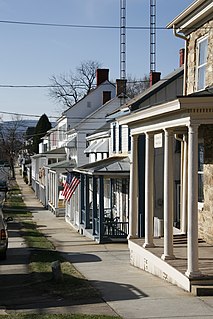
The Middletown Historic District comprises the historic center of Middletown, Maryland. Middletown became the chief community in the Middletown Valley in the late 18th century, retaining its importance until the 1930s, when the expanding influence of Frederick, Maryland, the construction of a bypass on US 40 and the abandonment of the Hagerstown and Frederick Railway produced a gradual decline. The historic district preserves many mid-19th-century buildings in the central downtown area. To the east, the district includes early 20th-century houses built along the trolley right-of-way, forming a streetcar suburb. The Airview Historic District includes a related area of early 20th century development to the east of town along the National Pike, separated from the main district by a section of newer development.
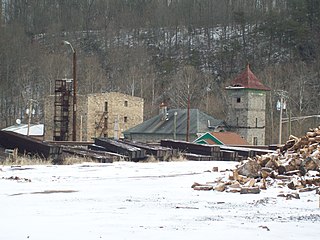
Daniels Mill is a historic mill complex located at Daniels, Howard County, Maryland, in a sheltered, wooded valley of the upper Patapsco River. The complex consists of seven early industrial structures, several concrete block and brick structures of 20th century date, and Gary Memorial United Methodist Church, a granite church built in the High Victorian Gothic style with an off-center tower entrance on the west gable. South of the church is a small cemetery.

The Savage Mill Historic District is a national historic district located at Savage, Howard County, Maryland. The district comprises the industrial complex of Savage Mill and the village of workers' housing to the north of the complex.

The Stonebraker and Harbaugh–Shafer Building in Middletown, Maryland was built circa 1830 with a residential section to the east and a commercial section to the west. The Federal style building incorporates Greek Revival detailing in the interior.

Larkin's Hill Farm is a historic home at Harwood, Anne Arundel County, Maryland, United States. It is a 1+1⁄2-story gambrel-roofed brick house with a 20th-century wing. In 1683 the estate served as a temporary capital of Maryland. John Larkin, an early Quaker settler in the area, later operated an inn here as a stopping place on the first regular postal route in Maryland, which ran from St. Mary's City to Annapolis. The present brick house was built during the ownership of Lord High Sheriff of Annapolis Captain John Gassaway, the grandson of pioneer politician Colonel Nicholas Gassaway, shortly after his acquisition of the property in 1753.

The Inns on the National Road is a national historic district near Cumberland, Allegany County, Maryland. It originally consisted of 11 Maryland inns on the National Road and located in Allegany and Garrett counties. Those that remain stand as the physical remains of the almost-legendary hospitality offered on this well-traveled route to the west.

Williston Mill Historic District is a national historic district in Denton, Caroline County, Maryland. It consists of two historic structures—a grist mill and a miller's house—which share the acreage with the mill stream and race that empties into Mill Creek, a tributary of the Choptank River. The Williston miller's house is a two-story, four-bay single-pile frame dwelling, built originally between 1840 and 1850 with later 19th century expansions. The mill building dates from around 1830–1840, with the two-story section built around 1895. It is one of two grist mills that remain standing in Caroline County.

The Routzahn-Miller Farmstead is a historic home and farm complex located at Middletown, Frederick County, Maryland, United States. It consists of a Federal style-influenced brick house and smokehouse, both built about 1825; a later frame out-kitchen / washhouse; a standard Pennsylvania barn; a 20th-century dairy barn and milk house; and a 20th-century equipment shed. The Pennsylvania barn was probably built in the late 19th century and was recently rehabilitated for use as a preschool. The complex is located on a 16.7-acre (68,000 m2) parcel on the east flank of South Mountain. It is representative example of a type of domestic and agricultural grouping which characterized the rural mid-Maryland region from the early 19th century through World War II era.
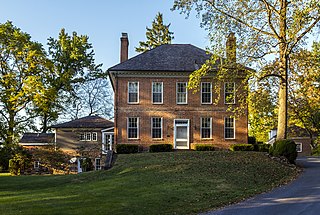
Woods Mill Farm is a historic home and farm complex located at Woodsboro, Frederick County, Maryland. It includes the Colonel Joseph Wood House and associated buildings. The house is an unusual example of an 18th-century brick, Georgian style manor house, built about 1770. It is a two-story brick dwelling with a hipped roof and inside end chimneys. The property also includes two distinctive outbuildings: a two-story, two-room stone and brick smokehouse with a gable roof and a brick end barn built about 1830. The original owner of this property was Col. Joseph Wood, founder of Woodsberry.
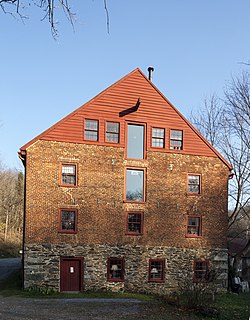
Lewis Mill Complex is a historic grist mill complex located at Jefferson, Frederick County, Maryland. The complex consists of seven standing structures, a house foundation, and the remains of an earlier millrace. It centers on an early 19th-century three-story brick mill structure with a gabled roof. The mill complex served German immigrant farmers in Middletown Valley between 1810 and the 1920s. It was rehabilitated in 1979-1980 for use as a pottery shop. Also in the complex are a stuccoed log house and log springhouse built about; a frame wagon shed and corn crib structure and frame barn dating from the late 19th century; and early 20th century cattle shelter and a frame garage.
Marsh Mills, also known as Haley's Mill or Spielman Mill, is a historic home located at Fairplay, Washington County, Maryland, United States. It is a 2+1⁄2-story, three-bay-wide limestone house. The structure was built about 1850 as a mill, then converted to a creamery in the 1880s. Traces of the millrace are still visible where it exits the south end of the building and passes beneath the road. Also on the property is an American Foursquare–style frame house which may incorporate remnants of the original log house which served as the original miller's dwelling.
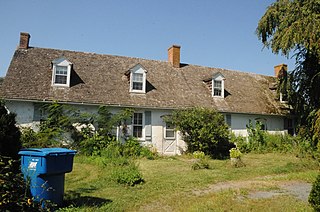
White House Farm is a historic home located at Kennedyville, Kent County, Maryland, United States. The oldest section of the 1+1⁄2-story stuccoed brick house was built in 1721. The house is located on an elevated site, within an informally landscaped yard which retains evidence of historic terracing. Also on the property is a late-19th-century brick dairy.

Stone Hill Historic District is a national historic district in Baltimore, Maryland, United States. It is one of the original mill villages along the Jones Falls, having been developed circa 1845–1847 to house textile mill workers. Comprising seven blocks, the district includes 21 granite duplexes, a granite Superintendent's House, and a granite service building – all owned by Mount Vernon Mills from 1845 to 1925.

Franklintown Historic District is a national historic district in Baltimore, Maryland, United States. It is the result of a plan developed in 1832 by William H. Freeman (1790–1863), a local politician and entrepreneur. His plan evolved gradually over the course of several decades and owes its success to his untiring promotion of the village. The central feature is an oval plan with radiating lots around a central wooded park. The district includes an old stone grist mill known as Franklin Mill, the innovative radiating oval plan, and the associated hotel and commercial area. The key residential buildings are excellent examples of the "I"-house form and display steeply pitched cross gables found in vernacular rural buildings throughout much of Maryland.
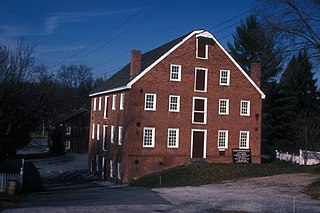
Union Mills Homestead Historic District is a national historic district at Westminster, Carroll County, Maryland, United States.

Lehman's Mill Historic District is a national historic district at Hagerstown, Washington County, Maryland, United States. The district comprises the remaining buildings of the mill group including the brick Lehman's Mill, built in 1869 for Henry F. Lehman, the farmstead with a stuccoed stone house dated 1837 with older and newer sections, a barn, carriage house, and agricultural outbuildings; another dwelling, also built by Lehman in 1877, a two-story brick and frame house; related outbuildings, and a portion of the mill's head and tail race. It is the oldest continuously operating mill in Washington County, and is the most intact mill complex remaining in the county.

Rolling Mill Historic District is a national historic district located at Cumberland, Allegany County, Maryland. It is a 38-acre (15 ha) primarily residential historic district located on the east side of the city of Cumberland. It contains a strong, locally distinctive concentration of wood and brick residences built between the early 1870s and the late 1940s. It also includes a modest commercial area. The district has a total of 173 properties, including the previously listed Francis Haley House.

Klots Throwing Company Mill is a historic silk mill located at Cumberland in Allegany County, Maryland, United States. It was built in 1902–1903, and is a long two-story brick building with double-gable roofs and paired stepped parapets. An addition was built in 1909. It was operated by Gentex Corporation and closed in 1972. The building was subsequently used for storage. From 1988 until 2002, the north end of the building housed the Western Maryland Food Bank. The building will be converted to loft apartments.
The Henry Smeltzer Farmstead is a historic home and farm complex located near Middletown, Frederick County, Maryland, United States. It includes a two-story six-bay brick farmhouse dating to about 1832, a frame bank barn ruin, and several rusticated concrete block silos. A concrete block slaughter house, weighing house well house and holding pens complete the complex, which was associated in the early and mid-twentieth century with Main's Meats in Middletown. The house is built into the hillside as a "bank house", with its cellar above grade on the south side. The front and rear elevations feature porches across their widths.






















